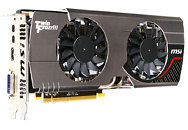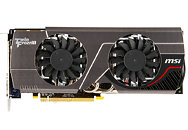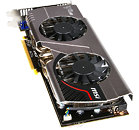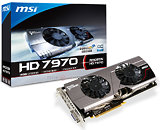- Joined
- Oct 9, 2007
- Messages
- 47,670 (7.43/day)
- Location
- Dublin, Ireland
| System Name | RBMK-1000 |
|---|---|
| Processor | AMD Ryzen 7 5700G |
| Motherboard | Gigabyte B550 AORUS Elite V2 |
| Cooling | DeepCool Gammax L240 V2 |
| Memory | 2x 16GB DDR4-3200 |
| Video Card(s) | Galax RTX 4070 Ti EX |
| Storage | Samsung 990 1TB |
| Display(s) | BenQ 1440p 60 Hz 27-inch |
| Case | Corsair Carbide 100R |
| Audio Device(s) | ASUS SupremeFX S1220A |
| Power Supply | Cooler Master MWE Gold 650W |
| Mouse | ASUS ROG Strix Impact |
| Keyboard | Gamdias Hermes E2 |
| Software | Windows 11 Pro |
MSI announced a pair of Radeon HD 7970 graphics cards which feature PowerTune with Boost, yet aren't based on the HD 7970 GHz Edition chip. The company labeled these cards simply "HD 7970 Boost Edition." Among the cards MSI unveiled are a base-model (R7970 TF 3GD5 BE), and a factory-overclocked one (R7970 TF 3GD5 BE/OC). The base model features a GPU clock speed of 925 MHz, PowerTune Boost clock speed of 975 MHz, and memory speed of 5.50 GHz. The OC variant, on the other hand, features a GPU clock speed of 1000 MHz, Boost clock of 1050 MHz, and memory clock of the same 5.50 GHz. Hence neither conform to AMD's HD 7970 GHz Edition specs.
Both cards are based on custom designed PCBs and cooling solutions, by MSI. Its trusty Twin Frozr III cooling solution, which uses a pair of 80 mm "Propeller Blade" (high sweep) fans to ventilate a dense heatpipe-fed aluminum fin stack; is in charge of cooling the GPU, while a heatspreader looks after the memory and VRM. TDP of both cards is rated at 253W, both cards draw power from a combination of 8-pin and 6-pin PCIe power connectors. Display outputs on both cards include a dual-link DVI, an HDMI 1.4a, and two mini-DisplayPort 1.2 connectors. MSI did not reveal pricing.




View at TechPowerUp Main Site
Both cards are based on custom designed PCBs and cooling solutions, by MSI. Its trusty Twin Frozr III cooling solution, which uses a pair of 80 mm "Propeller Blade" (high sweep) fans to ventilate a dense heatpipe-fed aluminum fin stack; is in charge of cooling the GPU, while a heatspreader looks after the memory and VRM. TDP of both cards is rated at 253W, both cards draw power from a combination of 8-pin and 6-pin PCIe power connectors. Display outputs on both cards include a dual-link DVI, an HDMI 1.4a, and two mini-DisplayPort 1.2 connectors. MSI did not reveal pricing.




View at TechPowerUp Main Site





